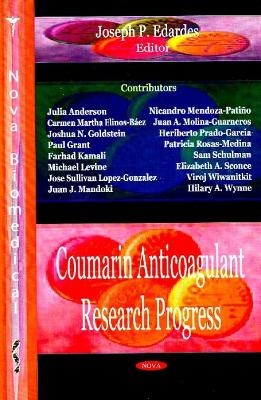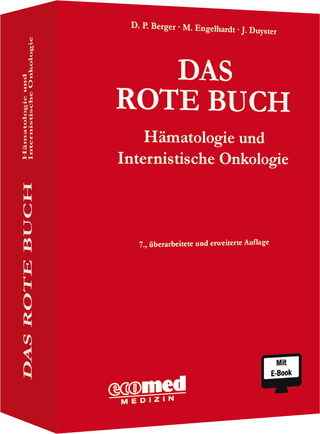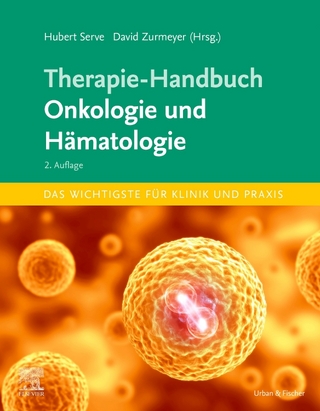
Coumarin Anticoagulant Research Progress
Seiten
2008
Nova Science Publishers Inc (Verlag)
978-1-60021-990-0 (ISBN)
Nova Science Publishers Inc (Verlag)
978-1-60021-990-0 (ISBN)
Warfarin (also known as Coumadin, Jantoven, Marevan, and Waran) is an anticoagulant medication that is administered orally or, very rarely, by injection. It is used for the prophylaxis of thrombosis and embolism in many disorders. Its activity has to be monitored by frequent blood testing for the international normalised ratio (INR).
Warfarin (also known under the brand names of Coumadin, Jantoven, Marevan, and Waran) is an anticoagulant medication that is administered orally or, very rarely, by injection. It is used for the prophylaxis of thrombosis and embolism in many disorders. Its activity has to be monitored by frequent blood testing for the international normalised ratio (INR). It is named for the Wisconsin Alumni Research Foundation. Warfarin is a synthetic derivative of coumarin, a chemical found naturally in many plants, notably woodruff (Galium odoratum, Rubiaceae), and at lower levels in liquorice, lavender and various other species. Warfarin was originally developed as a rat poison; however, more modern poisons are much more potent and toxic (e.g., brodifacoum). Warfarin and contemporary rodenticides belong to the same class of drugs (coumarins) and both decrease blood coagulation by interfering with vitamin K metabolism. For this reason, drugs in this class are also referred to as vitamin K antagonists.
Warfarin (also known under the brand names of Coumadin, Jantoven, Marevan, and Waran) is an anticoagulant medication that is administered orally or, very rarely, by injection. It is used for the prophylaxis of thrombosis and embolism in many disorders. Its activity has to be monitored by frequent blood testing for the international normalised ratio (INR). It is named for the Wisconsin Alumni Research Foundation. Warfarin is a synthetic derivative of coumarin, a chemical found naturally in many plants, notably woodruff (Galium odoratum, Rubiaceae), and at lower levels in liquorice, lavender and various other species. Warfarin was originally developed as a rat poison; however, more modern poisons are much more potent and toxic (e.g., brodifacoum). Warfarin and contemporary rodenticides belong to the same class of drugs (coumarins) and both decrease blood coagulation by interfering with vitamin K metabolism. For this reason, drugs in this class are also referred to as vitamin K antagonists.
Preface; Expert Commentary; Emergency Warfarin Reversal; Research and Review Studies; Coumarin Anticoagulants & Endocrine Interactions; Factors Affecting Anticoagulation Response to Warfarin; Warfarin -- New Approaches to Improve Safety; Mechanism of Antitumor Effects of Simple Coumarins in Murine Melanoma and Human Non-Small Cell Lung Carcinoma Cell Lines; A Topic on Coumarin Intoxication; Coumarin and 70H-Coumarin as Anti-carcinogenic Agents. Inhibition of the K-ras Oncogene in Human Lung Cancer; Genetic Polymorphism and Courmarin Metabolism; Index.
| Erscheint lt. Verlag | 19.2.2008 |
|---|---|
| Zusatzinfo | Illustrations |
| Verlagsort | New York |
| Sprache | englisch |
| Maße | 260 x 180 mm |
| Gewicht | 522 g |
| Themenwelt | Medizinische Fachgebiete ► Innere Medizin ► Hämatologie |
| Medizin / Pharmazie ► Medizinische Fachgebiete ► Pharmakologie / Pharmakotherapie | |
| ISBN-10 | 1-60021-990-X / 160021990X |
| ISBN-13 | 978-1-60021-990-0 / 9781600219900 |
| Zustand | Neuware |
| Haben Sie eine Frage zum Produkt? |
Mehr entdecken
aus dem Bereich
aus dem Bereich
Hämatologie und Internistische Onkologie
Buch | Softcover (2023)
ecomed-Storck GmbH (Verlag)
129,99 €
Buch | Softcover (2024)
Urban & Fischer in Elsevier (Verlag)
54,00 €
Buch | Softcover (2023)
Deutscher Ärzteverlag
29,99 €


